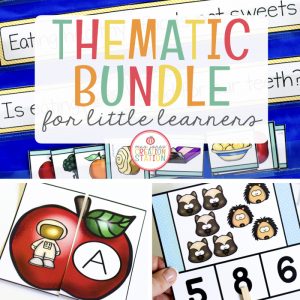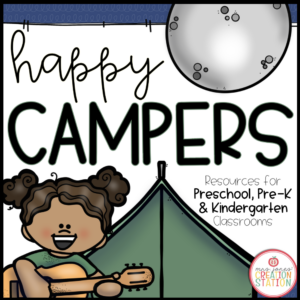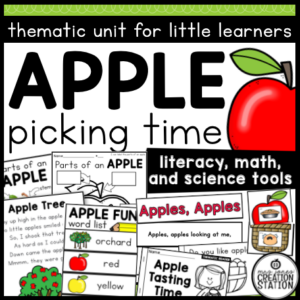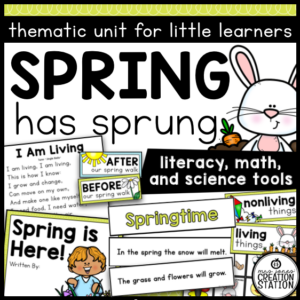WEATHER UNIT FOR PRESCHOOL, PRE-K AND KINDERGARTEN
This resource includes thematic weather lessons, activities, poems, songs and centers for your little learners.
Buy the BUNDLE and SAVE! You can purchase this resources in the Thematic Activities for Little Learners Bundle and the Little Learners Mega-Bundle!
____________________________________________________________________
THIS RESOURCE INCLUDES
Lesson Resources
Week 28 Plans
This is a template for lesson plans during a weather unit. Pick and choose what ideas and resources work for your learners.
Weather – Whole Group
These resources can be used during whole group instruction for a weather theme. They include a poem, word cards, tracing page and table sign in sheets.
Interactive Poem
Use this poem during a thematic lesson, whole group or a literacy center and have learners learn different types of weather.
Lesson Plans
Thematic Plans
Use these plans as a guide for engaging weather read alouds and activities in the classroom.
Weather
Read What Will the Weather Be? and create a chart for each type of weather. Learners may write the name of the weather for each picture in their flip book.
Temperature
Read What is a Thermometer? and sort the picture by their temperature. Create a thermometer together and observe changes between hot and cold.
Clouds
Read Explore My World: Clouds and read the Cloud poem together. Have learners create the three main types of clouds using cotton balls or puffy paint.
Precipitation
Read What is Precipitation? and create the precipitation chart together. Complete the How Clouds Make Rain experiment to should how precipitation falls.
Wild Weather
Read Wild Weather and review information learners have already heard.. Complete the Extreme Weather chart and have learners document information they learned throughout the week.
Sensory Charts
Explore weather with the five senses. Complete the charts together and have learners draw and write about what they experience with weather using their senses on the interactive page.
Predictable Chart Class Book
Use this resource to create a class book from the predictable chart created during the week.
Literacy Centers
Literacy Center | Alphabet Pocket Chart
Have learners sort the capital, lowercase and picture card for each letter of the alphabet on a pocket chart.
Literacy Center | Missing Sound
Have learners find the missing ending sounds for each of the CVC words.
Literacy Center | Sight Word
Have learners choose a sight word card and have them read, build and write the word.
Math Centers
Math Center | Addition
Have learners choose a rain card and add the total number of raindrops using the mats provided.
Math Center | Making Ten
Have learners write the number of clouds on each card and the number of clouds needed to make ten.
Math Center | Number Order
Have learners put the cards in order from one to twenty or counting down from twenty to one.
LEARNING STANDARDS INCLUDED IN THIS RESOURCE
Common Core Standards
Language Arts
CCSSL.K.1a
Print many upper- and lowercase letters.
CCSSL.K.5a
Sort common objects into categories (e.g., shapes, foods) to gain a sense of the concepts the categories represent.
CCSSL.K.5c
Identify real-life connections between words and their use (e.g., note places at school that are colorful).
CCSSRF.K.1b
Recognize that spoken words are represented in written language by specific sequences of letters.
CCSSRF.K.1c
Understand that words are separated by spaces in print.
CCSSRF.K.1d
Recognize and name all upper- and lowercase letters of the alphabet.
CCSSRF.K.2
Demonstrate understanding of spoken words, syllables, and sounds (phonemes).
CCSSRF.K.2d
Isolate and pronounce the initial, medial vowel, and final sounds (phonemes) in three-phoneme (consonant-vowel-consonant, or CVC) words. (This does not include CVCs ending with /l/, /r/, or /x/.)
CCSSRF.K.3
Know and apply grade-level phonics and word analysis skills in decoding words.
CCSSRF.K.3c
Read common high-frequency words by sight (e.g., the, of, to, you, she, my, is, are, do, does).
CCSSRI.K.2
With prompting and support, identify the main topic and retell key details of a text.
CCSSRI.K.7
With prompting and support, describe the relationship between illustrations and the text in which they appear (e.g., what person, place, thing, or idea in the text an illustration depicts).
CCSSRL.K.4
Ask and answer questions about unknown words in a text.
CCSSRL.K.7
With prompting and support, describe the relationship between illustrations and the story in which they appear (e.g., what moment in a story an illustration depicts).
CCSSSL.K.5
Add drawings or other visual displays to descriptions as desired to provide additional detail.
CCSSW.K.2
Use a combination of drawing, dictating, and writing to compose informative/explanatory texts in which they name what they are writing about and supply some information about the topic.
Math
CCSSK.CC.A.2
Count forward beginning from a given number within the known sequence (instead of having to begin at 1).
CCSSK.CC.A.3
Write numbers from 0 to 20. Represent a number of objects with a written numeral 0-20 (with 0 representing a count of no objects).
CCSSK.CC.B.4
Understand the relationship between numbers and quantities; connect counting to cardinality.
CCSSK.CC.B.4a
When counting objects, say the number names in the standard order, pairing each object with one and only one number name and each number name with one and only one object.
CCSSK.CC.B.4b
Understand that the last number name said tells the number of objects counted. The number of objects is the same regardless of their arrangement or the order in which they were counted.
CCSSK.CC.B.5
Count to answer “how many?” questions about as many as 20 things arranged in a line, a rectangular array, or a circle, or as many as 10 things in a scattered configuration; given a number from 1-20, count out that many objects.
CCSSK.OA.A.1
Represent addition and subtraction with objects, fingers, mental images, drawings, sounds (e.g., claps), acting out situations, verbal explanations, expressions, or equations.
CCSSK.OA.A.2
Solve addition and subtraction word problems, and add and subtract within 10, e.g., by using objects or drawings to represent the problem.
Next Generation Science Standards
NGSSK-ESS3-2
Ask questions to obtain information about the purpose of weather forecasting to prepare for, and respond to, severe weather. Emphasis is on local forms of severe weather.
NGSSK-ESS2-1
Use and share observations of local weather conditions to describe patterns over time. Examples of qualitative observations could include descriptions of the weather (such as sunny, cloudy, rainy, and warm); examples of quantitative observations could include numbers of sunny, windy, and rainy days in a month. Examples of patterns could include that it is usually cooler in the morning than in the afternoon and the number of sunny days versus cloudy days in different months. Assessment of quantitative observations limited to whole numbers and relative measures such as warmer/cooler.
Texas Essential of Knowledge and Skills
Language Arts
TEKSLA.K.2.A.iii
Developing and sustaining foundational language skills: listening, speaking, reading, writing, and thinking–beginning reading and writing… The student is expected to: demonstrate phonological awareness by: identifying the individual words in a spoken sentence.
TEKSLA.K.2.B.ii
Developing and sustaining foundational language skills: listening, speaking, reading, writing, and thinking–beginning reading and writing… The student is expected to: demonstrate and apply phonetic knowledge by: using letter-sound relationships to decode, including VC, CVC, CCVC, and CVCC words.
TEKSLA.K.2.B.iv
Developing and sustaining foundational language skills: listening, speaking, reading, writing, and thinking–beginning reading and writing…The student is expected to: demonstrate and apply phonetic knowledge by: identifying and reading at least 25 high-frequency words from a research-based list.
TEKSLA.K.2.C.i
Developing and sustaining foundational language skills: listening, speaking, reading, writing, and thinking–beginning reading and writing…The student is expected to: demonstrate and apply spelling knowledge by: spelling words with VC, CVC, and CCVC.
TEKSLA.K.2.C.iii
Developing and sustaining foundational language skills: listening, speaking, reading, writing, and thinking–beginning reading and writing… The student is expected to: demonstrate and apply spelling knowledge by: spelling high-frequency words from a research-based list.
TEKSLA.K.2.D.v
Developing and sustaining foundational language skills: listening, speaking, reading, writing, and thinking–beginning reading and writing…The student is expected to: demonstrate print awareness by: identifying all uppercase and lowercase letters.
TEKSLA.K.2.E
Developing and sustaining foundational language skills: listening, speaking, reading, writing, and thinking–beginning reading and writing…The student is expected to: develop handwriting by accurately forming all uppercase and lowercase letters using appropriate directionality.
TEKSLA.K.5.B
Comprehension skills: listening, speaking, reading, writing, and thinking using multiple texts…The student is expected to: generate questions about text before, during, and after reading to deepen understanding and gain information with adult assistance.
TEKSLA.K.5.H
Comprehension skills: listening, speaking, reading, writing, and thinking using multiple texts…The student is expected to: synthesize information to create new understanding with adult assistance.
TEKSLA.K.5.I
Comprehension skills: listening, speaking, reading, writing, and thinking using multiple texts…The student is expected to: monitor comprehension and make adjustments such as re-reading, using background knowledge, checking for visual cues, and asking questions when understanding breaks down with adult assistance.
TEKSLA.K.6.B
Response skills: listening, speaking, reading, writing, and thinking using multiple texts. The student responds to an increasingly challenging variety of sources that are read, heard, or viewed. The student is expected to: provide an oral, pictorial, or written response to a text.
TEKSLA.K.6.F
Response skills: listening, speaking, reading, writing, and thinking using multiple texts. The student responds to an increasingly challenging variety of sources that are read, heard, or viewed. The student is expected to: respond using newly acquired vocabulary as appropriate.
Math
TEKSMA.K.2.A
Number and operations. The student applies mathematical process standards to understand how to represent and compare whole numbers, the relative position and magnitude of whole numbers, and relationships within the numeration system. The student is expected to: count forward and backward to at least 20 with and without objects.
TEKSMA.K.2.B
Number and operations. The student applies mathematical process standards to understand how to represent and compare whole numbers, the relative position and magnitude of whole numbers, and relationships within the numeration system. The student is expected to: read, write, and represent whole numbers from 0 to at least 20 with and without objects or pictures.
TEKSMA.K.2.I
Number and operations. The student applies mathematical process standards to understand how to represent and compare whole numbers, the relative position and magnitude of whole numbers, and relationships within the numeration system. The student is expected to: compose and decompose numbers up to 10 with objects and pictures.
TEKSMA.K.3.A
Number and operations. The student applies mathematical process standards to develop an understanding of addition and subtraction situations in order to solve problems. The student is expected to: model the action of joining to represent addition and the action of separating to represent subtraction.
Science
TEKSSCI.K.8.A
Earth and space. The student knows that there are recognizable patterns in the natural world and among objects in the sky. The student is expected to: observe and describe weather changes from day to day and over seasons;
TEKSSCI.K.8.C
Earth and space. The student knows that there are recognizable patterns in the natural world and among objects in the sky. The student is expected to: observe, describe, and illustrate objects in the sky such as the clouds, Moon, and stars, including the Sun.
CONNECT WITH MJCS
WEBSITE | FACEBOOK | INSTAGRAM | PINTEREST | TEACHERS PAY TEACHERS
© Mrs. Jones’ Creation Station, Inc




